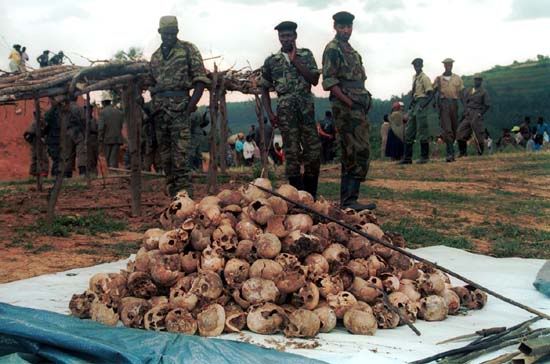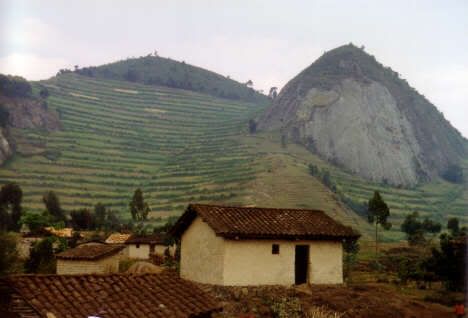 Violence permanently stained the history of Rwanda from before the establishment of its independence to the modern day, the three primary tribes that inhabit the country constantly fight over land and power over the country. The Tutsi and Hutu, the two prominent tribes in Rwanda that together cause the most damage, have fought over governmental positions since the time that Germany and Belgium ruled with the “domestic” feuds escalating into one of the largest wars and genocides of the twentieth century. The beginning of the genocide instigated when the Hutu took over the government and exiled or murdered the opposing Tutsi tribe to Uganda. For a few years the Tutsi planned their return to Rwanda through the use of violence against absolutely every person that they saw get in the way of their dash toward the government. The fight between the Tutsi and Hutu was at its peak in 1994 when the fighting became indiscriminate between ethnicity, age, or tribe; everyone that got in the way was murdered. Eventually the fighting slowed down when the Tutsi regained control over the government and banished all rebel Hutu to Uganda. The fighting never completely ceased because the banished Hutu continually attacked random villages in rebellion against the Rwandan government. In 1996, the government decided to solve this problem by invading Uganda and killing the remaining Hutu resistance in an attempt to establish equality and safety in Rwanda.
Violence permanently stained the history of Rwanda from before the establishment of its independence to the modern day, the three primary tribes that inhabit the country constantly fight over land and power over the country. The Tutsi and Hutu, the two prominent tribes in Rwanda that together cause the most damage, have fought over governmental positions since the time that Germany and Belgium ruled with the “domestic” feuds escalating into one of the largest wars and genocides of the twentieth century. The beginning of the genocide instigated when the Hutu took over the government and exiled or murdered the opposing Tutsi tribe to Uganda. For a few years the Tutsi planned their return to Rwanda through the use of violence against absolutely every person that they saw get in the way of their dash toward the government. The fight between the Tutsi and Hutu was at its peak in 1994 when the fighting became indiscriminate between ethnicity, age, or tribe; everyone that got in the way was murdered. Eventually the fighting slowed down when the Tutsi regained control over the government and banished all rebel Hutu to Uganda. The fighting never completely ceased because the banished Hutu continually attacked random villages in rebellion against the Rwandan government. In 1996, the government decided to solve this problem by invading Uganda and killing the remaining Hutu resistance in an attempt to establish equality and safety in Rwanda.

Even though the Rwandan government works toward peace and a more stable economy, the outlook is bleak because several of the children have been left in the worst circumstances, such as poverty and mental illness. Twenty percent of Rwanda's children have been left parentless, forced to care for themselves, and dealing with anxiety disorders from the horrific scenes that they witnessed daily. For the longest time the children that have been forced to live on the streets have been overlooked by the government, so these kids were reduced to stealing and other questionable means of surviving leaving them at the bottom of the social hierarchy. In the later twentieth century, several humanitarian organizations focused their energy primarily on the orphans of Rwanda in an attempt to educate and rehabilitate them in order to reincorporate them back into society and eventually fix Rwanda's failing economy. The future still looks bleak for the people of Rwanda because they continue to focus on the present rather than the future, so a majority of the children are forced to drop out of school and work in the fields in an attempt to bring in addition income for themselves or their family.
Striding Girl illustrates a s
 cene two years after the Rwandan genocide, during the time when the government invades Uganda and the rebels randomly attack people and entire villages. Every aspect of the photo reveals the angst in daily life of the Ugandan people, from the dark, muted hues to the vectors of attention working to unravel a piece of Rwandan life. Rhetorical appeals are woven together to reveal an underlying allegory about the state in which Rwanda finds itself and the circle of events that continually reappear throughout its history. The allegory alludes to the crossroads that Rwanda finds itself at in this part of history, governmental decisions that can lead the country to economic prosperity or continual failure based upon the next generation of children. Simply the image of the young girl walking up the road toward an unknown destination strikes the attention of the audience as the vectors of attention circulate a around the setting of the photo illustrating the story of the girl and Rwanda in the moment. Striding Girl illuminates the angsty mood in Rwanda only a few years after the genocide. The photo attempts to invoke pathos through logos with the rhetorical appeals of vectors of attention, coloration, and cropping to describe the unfortunate situation that Rwanda finds itself two years after the infamous genocide ends.
cene two years after the Rwandan genocide, during the time when the government invades Uganda and the rebels randomly attack people and entire villages. Every aspect of the photo reveals the angst in daily life of the Ugandan people, from the dark, muted hues to the vectors of attention working to unravel a piece of Rwandan life. Rhetorical appeals are woven together to reveal an underlying allegory about the state in which Rwanda finds itself and the circle of events that continually reappear throughout its history. The allegory alludes to the crossroads that Rwanda finds itself at in this part of history, governmental decisions that can lead the country to economic prosperity or continual failure based upon the next generation of children. Simply the image of the young girl walking up the road toward an unknown destination strikes the attention of the audience as the vectors of attention circulate a around the setting of the photo illustrating the story of the girl and Rwanda in the moment. Striding Girl illuminates the angsty mood in Rwanda only a few years after the genocide. The photo attempts to invoke pathos through logos with the rhetorical appeals of vectors of attention, coloration, and cropping to describe the unfortunate situation that Rwanda finds itself two years after the infamous genocide ends.
The photo cleverly uses logos in the construction of the focal points to strategically lead the eye of the audience to illustrate the theme of crossroads or an unknown journey.
The next vector of attention provides an answer to the question the the photo propos es by moving the audience's attention from the foreground to the subtle background and everything that it ultimately serves to conceal. Again the lighting of the photo plays a dominant role because it subtly steers the eye away from the road toward the darkened forest in the background. Rwanda is primarily an agrarian country, therefore fields such as the one illustrated in the photo are important to society but it appears that there are no people around to farm the land. Low saturation accounts for the almost invisible white buildings hidden amongst the foliage since the hue is almost as dark as the surrounding dark green of the trees and bushes. The buildings provide a plausible answer to where the girl may be going, a village that is hidden within the trees.
es by moving the audience's attention from the foreground to the subtle background and everything that it ultimately serves to conceal. Again the lighting of the photo plays a dominant role because it subtly steers the eye away from the road toward the darkened forest in the background. Rwanda is primarily an agrarian country, therefore fields such as the one illustrated in the photo are important to society but it appears that there are no people around to farm the land. Low saturation accounts for the almost invisible white buildings hidden amongst the foliage since the hue is almost as dark as the surrounding dark green of the trees and bushes. The buildings provide a plausible answer to where the girl may be going, a village that is hidden within the trees.
No comments:
Post a Comment